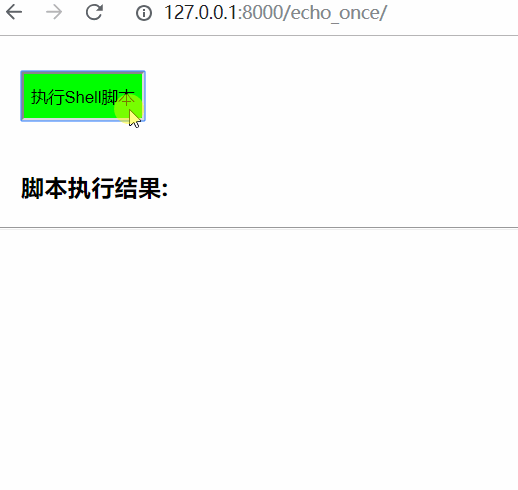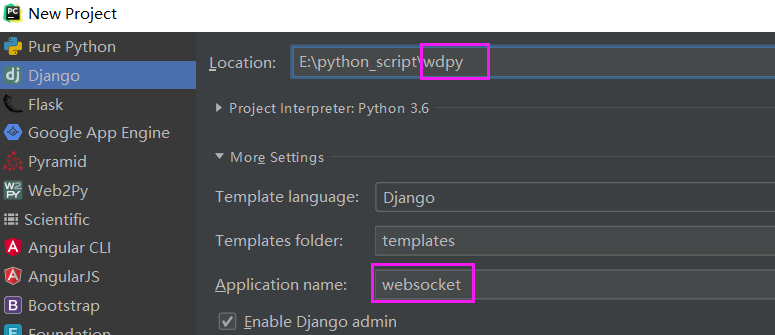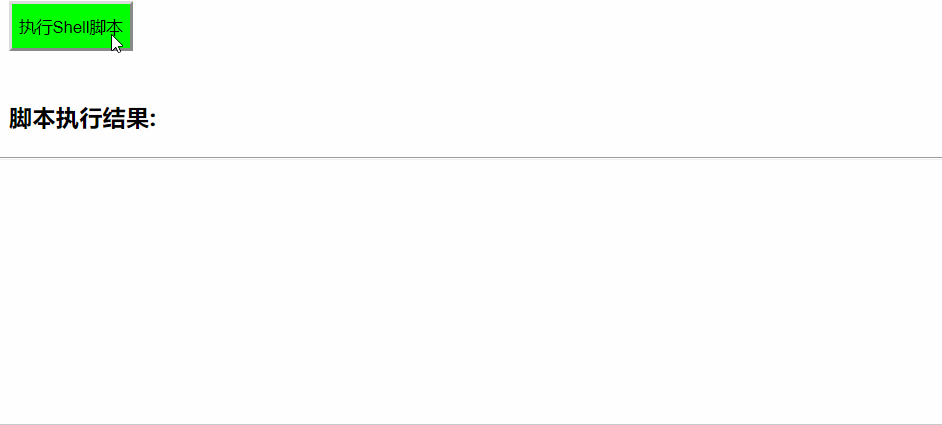websocket+Django+python+paramiko实现web页面执行命令并实时输出
发布时间:2020-02-20 13:08:23编辑:admin阅读(3707)
一、概述
WebSocket
WebSocket的工作流程:浏览器通过JavaScript向服务端发出建立WebSocket连接的请求,在WebSocket连接建立成功后,客户端和服务端就可以通过 TCP连接传输数据。因为WebSocket连接本质上是TCP连接,不需要每次传输都带上重复的头部数据,所以它的数据传输量比轮询和Comet技术小很多。
paramiko
paramiko模块,基于SSH用于连接远程服务器并执行相关操作。
shell脚本
/opt/test.sh
#!/bin/bash
for i in {1..10}
do
sleep 0.5
echo 母鸡生了$i个鸡蛋;
done
网页执行脚本,效果如下:

怎么样,是不是很nb!下面会详细介绍如何具体实现!
二、详细操作
django版本
最新版本 2.1.5有问题,使用websocket,谷歌浏览器会报错
WebSocket connection to 'ws://127.0.01:8000/echo_once/' failed: Error during WebSocket handshake: Unexpected response code: 400
所以不能使用最新版本,必须使用 2.1.4以及2.x系列都可以!
安装模块
pip3 install paramiko dwebsocket django==2.1.4
创建项目
使用Pycharm创建一个项目 wdpy ,这个是测试的,名字无所谓!

添加路由,修改文件 urls.py
from django.contrib import admin
from django.urls import path
from websocket import views
urlpatterns = [
path('admin/', admin.site.urls),
path('echo_once/', views.echo_once),
]
修改views.py,增加视图函数
from django.shortcuts import render
from dwebsocket.decorators import accept_websocket, require_websocket
from django.http import HttpResponse
import paramiko
# def exec_command(comm):
# hostname = '192.168.0.162'
# username = 'root'
# password = 'root'
#
# ssh = paramiko.SSHClient()
# ssh.set_missing_host_key_policy(paramiko.AutoAddPolicy())
# ssh.connect(hostname=hostname, username=username, password=password)
# stdin, stdout, stderr = ssh.exec_command(comm,get_pty=True)
# result = stdout.read()
# ssh.close()
# yield result
@accept_websocket
def echo_once(request):
if not request.is_websocket(): # 判断是不是websocket连接
try: # 如果是普通的http方法
message = request.GET['message']
return HttpResponse(message)
except:
return render(request, 'index.html')
else:
for message in request.websocket:
message = message.decode('utf-8') # 接收前端发来的数据
print(message)
if message == 'backup_all':#这里根据web页面获取的值进行对应的操作
command = 'bash /opt/test.sh'#这里是要执行的命令或者脚本
# 远程连接服务器
hostname = '192.168.0.162'
username = 'root'
password = 'root'
ssh = paramiko.SSHClient()
ssh.set_missing_host_key_policy(paramiko.AutoAddPolicy())
ssh.connect(hostname=hostname, username=username, password=password)
# 务必要加上get_pty=True,否则执行命令会没有权限
stdin, stdout, stderr = ssh.exec_command(command, get_pty=True)
# result = stdout.read()
# 循环发送消息给前端页面
while True:
nextline = stdout.readline().strip() # 读取脚本输出内容
# print(nextline.strip())
request.websocket.send(nextline) # 发送消息到客户端
# 判断消息为空时,退出循环
if not nextline:
break
ssh.close() # 关闭ssh连接
else:
request.websocket.send('小样儿,没权限!!!'.encode('utf-8'))
在 templates 目录下新建文件 index.html
<!DOCTYPE html >
<html>
<head>
<meta http-equiv="Content-Type" content="text/html; charset=utf-8"/>
<title>CMDB系统</title>
<script src="/static/jquery-1.12.4.js"></script>
<script type="text/javascript">
$(function () {
$('#backup_all').click(function () {
var socket = new WebSocket("ws://" + window.location.host + "/echo_once/");
console.log(socket);
socket.onopen = function () {
console.log('WebSocket open');//成功连接上Websocket
socket.send($('#backup_all').val());//发送数据到服务端
};
socket.onmessage = function (e) {
console.log('message: ' + e.data);//打印服务端返回的数据
//$('#messagecontainer').prepend('<p><pre>' + e.data + '</pre></p>');
//$('#messagecontainer').prepend('<hr />');
$('#messagecontainer').append(e.data+'<br/>');
{#$('#messagecontainer').prepend('<hr />');#}
};
});
});
</script>
</head>
<body>
{#<br>#}
<button style="margin: 20px;height: 40px;background-color: #00ff00;" type="button" id="backup_all" value="backup_all">
执行Shell脚本
</button>
<h3 style="margin: 20px;">脚本执行结果:</h3>
<div id="messagecontainer" style="margin: 20px;">
</div>
<hr/>
</body>
</html>
和manage.py 同级目录,新建目录static,在里面放 jquery-1.12.4.js 文件
从百度搜索下载即可!
修改 settings.py ,设置satic路径
STATIC_URL = '/static/' STATICFILES_DIRS = ( os.path.join(BASE_DIR,"static"), )
requirements.txt 这个是项目依赖文件,内容如下:
Django==2.1.4 dwebsocket==0.5.10 paramiko==2.4.2
此时,目录结果如下:
./ ├── db.sqlite3 ├── manage.py ├── requirements.txt ├── static │ └── jquery-1.12.4.js ├── templates │ └── index.html ├── untitled2 │ ├── __init__.py │ ├── settings.py │ ├── urls.py │ └── wsgi.py └── websocket ├── admin.py ├── apps.py ├── __init__.py ├── migrations │ └── __init__.py ├── models.py ├── tests.py └── views.py
启动linux服务器
这里使用的是linux服务器,系统是 ubuntu-16.04.4-server-amd64
脚本 /opt/test.sh 就是上面的内容,已经设置了755权限
启动项目
使用Pycharm启动,访问网页:
http://127.0.0.1:8000/echo_once/
效果就是上面演示的!
测试命令
除了执行脚本,还可以执行其他命令,比如安装ntpdate
修改views.py,将 command 修改一下
command = 'apt-get install -y ntpdate'#这里是要执行的命令或者脚本
再次执行,效果如下:

完整项目
如需完整项目代码,请访问:
https://github.com/py3study/wdpy
本文参考链接:
https://blog.csdn.net/linxi7/article/details/76161584
注意:这篇文章的效果并不是实时输出,它是命令执行完成之后,才显示在网页上面的!
那么因此,我在他的代码基础上,做了一些改进!才实现 实时输出的效果!
- openvpn linux客户端使用
51622
- H3C基本命令大全
51230
- openvpn windows客户端使用
41710
- H3C IRF原理及 配置
38479
- Python exit()函数
32961
- openvpn mac客户端使用
29958
- python全系列官方中文文档
28643
- python 获取网卡实时流量
23618
- 1.常用turtle功能函数
23547
- python 获取Linux和Windows硬件信息
21896
- Python搭建一个RAG系统(分片/检索/召回/重排序/生成)
2075°
- Browser-use:智能浏览器自动化(Web-Agent)
2775°
- 使用 LangChain 实现本地 Agent
2319°
- 使用 LangChain 构建本地 RAG 应用
2251°
- 使用LLaMA-Factory微调大模型的function calling能力
2752°
- 复现一个简单Agent系统
2273°
- LLaMA Factory-Lora微调实现声控语音多轮问答对话-1
3041°
- LLaMA Factory微调后的模型合并导出和部署-4
4979°
- LLaMA Factory微调模型的各种参数怎么设置-3
4850°
- LLaMA Factory构建高质量数据集-2
3449°
- 姓名:Run
- 职业:谜
- 邮箱:383697894@qq.com
- 定位:上海 · 松江
